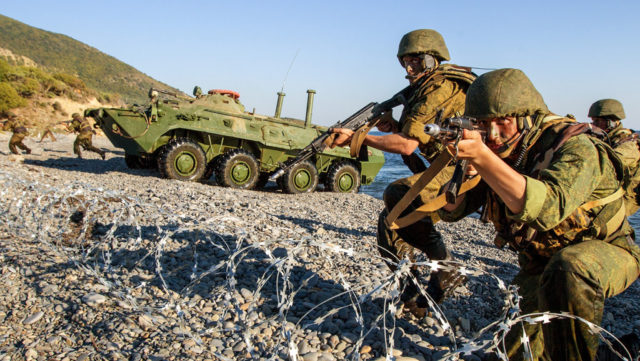
Russian Amphibious Capabilities—Kontraktniki and Rust Buckets (Part One)
Publication: Eurasia Daily Monitor Volume: 14 Issue: 67
By:

The year 2017 will probably finally see the new landing ship Ivan Gren handed over to the Russian Navy. This vessel was long fraught with delays and mishaps on its way from the shipyard to the Ministry of Defense (SM News, May 2). In September, Russia will also hold the exercise Zapad 2017, which will almost certainly include a simulated amphibious landing. How this is accomplished, its size and the scenario will be of special interest due to the charged military situation in the Baltic Sea region (see EDM, May 1, 2, 11). But it will also indicate something about Russia’s current amphibious capabilities, which are built on Moscow’s historical experiences from the Great Patriotic War and which were further developed during the Cold War.
In February 1944, the Soviets attempted to end the stalemate along the frontline at Narva by launching an amphibious landing behind the German lines at Meriküla. However, this ended in a disaster for the Soviet forces (Mil-history.livejournal.com, February 15, 2015). The Meriküla operation was one of many Soviet tactical amphibious landings during the Great Patriotic War, but none of them approached the enormous scale of Operation Overlord (which opened with the June 6, 1944, D-Day landings in Normandy). The Soviet forces also lacked specialized landing craft like landing craft tanks (LCT). Nonetheless, the country’s ability to accomplish amphibious operations matured in ensuing years. Assessments done during the Cold War suggested that the Soviet Union planned for large-scale amphibious operations at least in the Baltic Sea—in particular, targeting Denmark. In fact, the Soviet Armed Forces practiced such a scenario in large-scale exercises such as Priliv 1963, Rügen 1968, Val 1977 and ensuing drills in the spring and summer of 1978 (Diis.dk, 2005). The Soviet amphibious capabilities also had an impact on Swedish war plans, which focused on thwarting a possible Soviet landing in the central and southern part of the country. This is now history, but what is the present Russian amphibious capability and how might it develop?
In order to accomplish an amphibious landing, there is a need for units equipped and trained for such a task, naval infantry or mechanized infantry, landing craft, and enough assets to ensure command of the sea as well as the air in the actual landing area. Depending on the scope and aim of the landing, there is also a need for follow-on forces and a means to transport them. An amphibious landing is a highly complex operation; therefore, landing exercises are imperative in order to maintain and develop this capability over time.
Presently, the Naval Infantry is the only branch of the Russian Armed Forces organized, equipped and trained for amphibious operations (Defence.ru, November 27, 2016). In principle, they are heirs to the units existing during the Soviet era. Though like all other units that survived the chaos following the fall of the Soviet Union, the naval infantry has been subjected to certain changes. Namely:
- In 2014, the Northern Fleet’s 61st Naval Infantry Brigade (based in Sputnik, Murmansk oblast) upgraded from a regiment to a brigade with the addition of a battalion, a sniper company and logistics units (Vesti, November 28, 2014).
- The Baltic Fleet currently includes the 336st Naval Infantry Brigade (based in Baltijsk, Kaliningrad oblast).
- The Black Sea Fleet’s amphibious capabilities are carried out by the 810th Naval Infantry Brigade (Sevastopol, in occupied Crimea). In 1999, the freshly reorganized 264th Naval Infantry Regiment was renamed as the 810th, and, in 2008, it was upgraded to a brigade (Bastion-opk.ru, June 6, 2016).
- In the Caspian Flotilla, the 77th Naval Infantry Brigade was set up in 2000 but disbanded in 2008. Its remnants currently include the 414th and 727th Naval Infantry Battalions (Kaspiisk, Dagestan; and Astrakhan, Astrakhan oblast, respectively) (Mptaifun.ru, August 17, 2016).
- The Pacific Fleet has two amphibious assault units: the 155th Naval Infantry Brigade (Vladivostok, Primorsky krai) and the 40th Naval Infantry Brigade (Petropavlovsk-Kamchatsky, Kamchatka krai). The 155th is an heir to the 55th Naval Infantry Division, disbanded in 2009; while the latter unit was first organized in 2007 and, in 2009, reorganized as the 3rd Naval Infantry Regiment but, in 2013, resurrected as a brigade (Voennoe Obrozrenie, November 27 2013; Voinskayachast.net, accessed May 16, 2017).
This listing does not give the whole picture, and it raises a number of important questions: Have the naval infantry units been idle since 1991, and if not, how are they manned and equipped? Moreover, what are the means to transport the naval infantry, and what is the status of the Russian fleet of landing ships and plans for its development? Part Two of this article will seek to bring some clarity to these questions.



